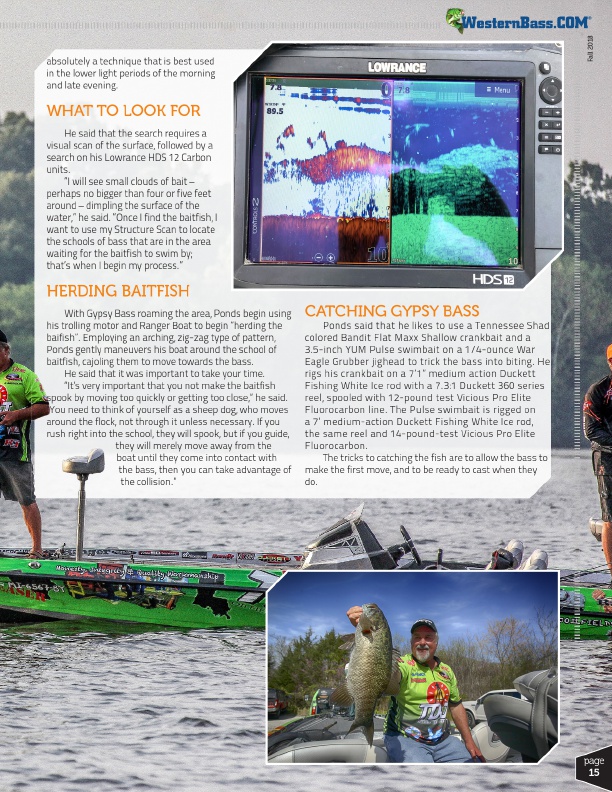
Fall 2018
absolutely a technique that is best used in the lower light periods of the morning and late evening.
WHAT TO LOOK FOR
He said that the search requires a visual scan of the surface, followed by a search on his Lowrance HDS 12 Carbon units.
“I will see small clouds of bait – perhaps no bigger than four or five feet around – dimpling the surface of the water,” he said. “Once I find the baitfish, I want to use my Structure Scan to locate the schools of bass that are in the area waiting for the baitfish to swim by; that’s when I begin my process.”
HERDING BAITFISH
With Gypsy Bass roaming the area, Ponds begin using his trolling motor and Ranger Boat to begin “herding the baifish”. Employing an arching, zig-zag type of pattern, Ponds gently maneuvers his boat around the school of baitfish, cajoling them to move towards the bass.
He said that it was important to take your time.
“It’s very important that you not make the baitfish spook by moving too quickly or getting too close,” he said. “You need to think of yourself as a sheep dog, who moves around the flock, not through it unless necessary. If you rush right into the school, they will spook, but if you guide,
they will merely move away from the
boat until they come into contact with
the bass, then you can take advantage of
the collision.”
CATCHING GYPSY BASS
Ponds said that he likes to use a Tennessee Shad colored Bandit Flat Maxx Shallow crankbait and a 3.5-inch YUM Pulse swimbait on a 1/4-ounce War Eagle Grubber jighead to trick the bass into biting. He rigs his crankbait on a 7’1” medium action Duckett Fishing White Ice rod with a 7.3:1 Duckett 360 series reel, spooled with 12-pound test Vicious Pro Elite Fluorocarbon line. The Pulse swimbait is rigged on a 7’ medium-action Duckett Fishing White Ice rod, the same reel and 14-pound-test Vicious Pro Elite Fluorocarbon.
The tricks to catching the fish are to allow the bass to make the first move, and to be ready to cast when they do.
®
page
15